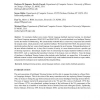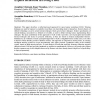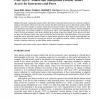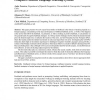AIEDU
2008
13 years 11 months ago
2008
To investigate whether more concise Natural Language feedback improves learning, we developed two Natural Language generators (DIAG-NLP1 and DIAG-NLP2), to provide feedback in an I...
AIEDU
2007
14 years 17 days ago
2007
Abstract. This paper discusses the simple open student models used in two of our constraint-based tutors, SQLd KERMIT, and their effects on self-assessment. The systems present a h...
AIEDU
2007
14 years 26 days ago
2007
This paper describes a reflection-based approach for open learner modeling (OLM). Tutoring dialogues are used by learners to explicitly reveal their own knowledge state to themselv...
AIEDU
2007
14 years 26 days ago
2007
Recently, opening the learner model to the learner it represents has become more common in adaptive learning environments. There have also been systems that allow instructors acces...
AIEDU
2007
14 years 26 days ago
2007
In recent years, the learner models of some adaptive learning environments have been opened to the learners they represent. However, as yet there is no standard way of describing a...
AIEDU
2007
14 years 26 days ago
2007
This study investigated the desirable characteristics of anthropomorphized learning-companion agents for college students. First, interviews with six undergraduates explored their ...
AIEDU
2007
14 years 26 days ago
2007
This paper presents two new corpus-based studies of feedback in the domain of teaching Spanish as a foreign language, concentrating on the type and frequency of different feedback ...
AIEDU
2007
14 years 26 days ago
2007
Research efforts focused on developing "active reports" are currently underway. Active reports are designed to foster communication among teachers, students, and parents ...
AIEDU
2007
14 years 26 days ago
2007
Opening a model of the learner is a potentially complex operation. There are many aspects of the learner that can be modelled, and many of these aspects may need to be opened in di...
AIEDU
2007
14 years 26 days ago
2007
We present an approach to designing intelligent tutoring systems, termed the Difficulty Factors Approach. In this approach, the designer investigates, at each iteration of the desi...




